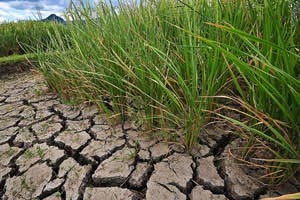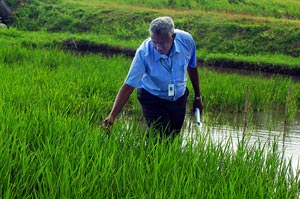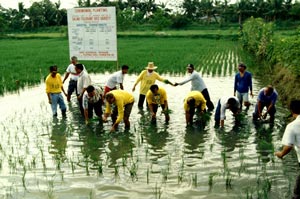Climate change-ready rice
Drought-tolerant rice varieties
 Drought is the most widespread and damaging of all environmental stresses, affecting 23 million hectares of rainfed rice in South and Southeast Asia.
Drought is the most widespread and damaging of all environmental stresses, affecting 23 million hectares of rainfed rice in South and Southeast Asia.
IRRI has developed drought-tolerant varieties, which have been released in several countries and are now being planted by farmers. These include Sahbhagi dhan in India, Sahod ulan in the Philippines, and the Sookha dhan varieties in Nepal. Field trials suggest that the average yield advantage of drought-tolerant varieties over drought-susceptible ones is 0.8–1.2 tons per hectare under drought conditions.
Submergence-tolerant rice varieties
 Rice plants normally die within four days of submergence. Farmers in countries with rice areas prone to flooding—such as the Philippines, Bangladesh, and India—lose millions tons of rice yearly due to floods.
Rice plants normally die within four days of submergence. Farmers in countries with rice areas prone to flooding—such as the Philippines, Bangladesh, and India—lose millions tons of rice yearly due to floods.
IRRI discovered SUB1, the gene for flood tolerance, and incorporated this gene into popular rice varieties. Field trials of rice varieties with the SUB1 gene have shown a yield advantage of 1–3 tons per hectare, following flooding of 10–15 days. Flood-tolerant varieties have been released and are now being planted across Asia. These include IR64-Sub1 in the Philippines, Swarna-Sub1 in India, Samba Mahsuri-Sub1 in Bangladesh, and Ciherang-Sub1 in Indonesia.
 Millions of hectares of land in Asia and Africa suitable for rice production are currently unproductive because of high or increasing salt content in soil. Rising sea levels bring saltwater further inland, contributing to soil salinity. Rice productivity in salt-affected areas is very low—less than 1.5 tons per hectare.
Millions of hectares of land in Asia and Africa suitable for rice production are currently unproductive because of high or increasing salt content in soil. Rising sea levels bring saltwater further inland, contributing to soil salinity. Rice productivity in salt-affected areas is very low—less than 1.5 tons per hectare.
A gene for salinity tolerance, called Saltol, has been incorporated into popular rice varieties in countries across Asia. In the Philippines, field trials of Salinas suggest a yield advantage of at least 2 tons per hectare over non-tolerant varieties.








